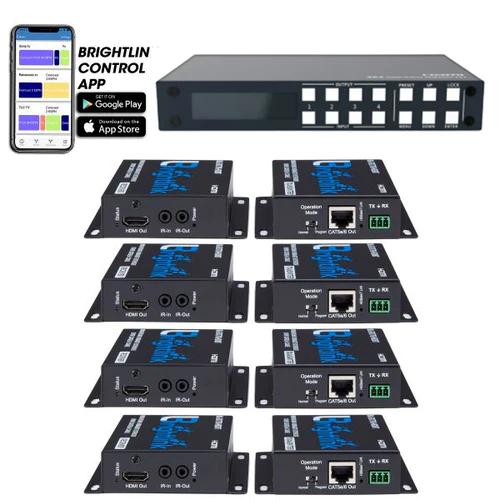






Nowadays, we all have many devices that connect to the monitor or TV through HDMI, but many times there comes the point where we run out of available ports. So, should you get an HDMI Splitter or an HDMI switch in these cases? There is a lot of confusion between HDMI switches and splitters. Both are useful with different functionalities. We tell you how the two differ and in what circumstances you should use one or the other. To improve transmission speed and signal strength, you can try a matrix set over cat6.
https://brightlinkav.com/
“Splitter” comes from the English verb “to Split,” which means to separate. In other words, a Splitter is used to split the signal from a single source to multiple screens. For example, you must have seen many TVs displaying the same pictures in electronic TV stores. Why do all TVs show the same picture or video on many devices? Here comes the HDMI splitter. Connect with Brightlink Av if you are looking for a 4x4 HDBaseT matrix at affordable prices.
That is why an HDMI Splitter will always have a single input, the video (and audio) source, and several outputs, where we can connect the screens where we want the image to be seen. Thus, we have Splitter from 1×2 (one input and two outputs) to 1×16 (one Input and sixteen outputs), of course going through 1×4, 1×8, etc. The HDMI Splitters will always emit the signal that enters them through the Input in all the Outputs, without exception. It is because they are the passive form of the splitters, which do not need additional power.
It is the basic form of HDMI splitter and is more than enough to run most applications. It takes data from one HDMI cable source and sends it to two HDMI cables.
This type best suits applications and installations where HDMI signals must be routed over longer distances. You can transmit signals over much more distances by using Cat 5E or Cat 6 cables.
An HDMI switch is just the opposite in the physical sense of a Splitter. It has multiple inputs and a single exit. In other words, it is a switched device in which only one signal is emitted at a time. Here is an example of any monitor or television to give you an idea of what we mean. Since they all have an internal HDMI switch, this is because they only have one panel and cannot display two video signals at the same time. Thanks to the HDMI switch, we can keep different devices connected to the various HDMI ports.
An external HDMI Switch is useful if we want to connect the PC or the console, but we lack HDMI ports. It would serve you to connect additional devices to the monitor. Its operation? You must press a button to switch between one signal source and another.
Before you buy an HDMI switch, here are a few things that you can look for:
Look For Resolution: Most HDMI switches offer 1080P; however, if you use a 4k device, check if your device accommodates that feature.
Home Theatre Capacity: Most HMDI can offer an advanced form of audio formats like Doby digital and DTS Digital Surround audio. However, you can also check out other formats like Dolby True HD, Atmos, DTS-HD Master Audio, DTS: X. HD, Atmos, DTS-HD Master Audio, and DTS: X.
HDMI Switch Handshake Requirements: For systems carrying 4K etc., ensure that the switch can handle HDMI handshake requirements which may include HDCP, high bandwidth digital copy protection, or HDCP 2.2
Brightlink provides high-quality Video Distribution & Display Equipment such as HDMI Matrix Switcher Systems, HDBaseT Matrix Switcher Systems, fiber optic HDMI cables, Video wall Sets, etc.
